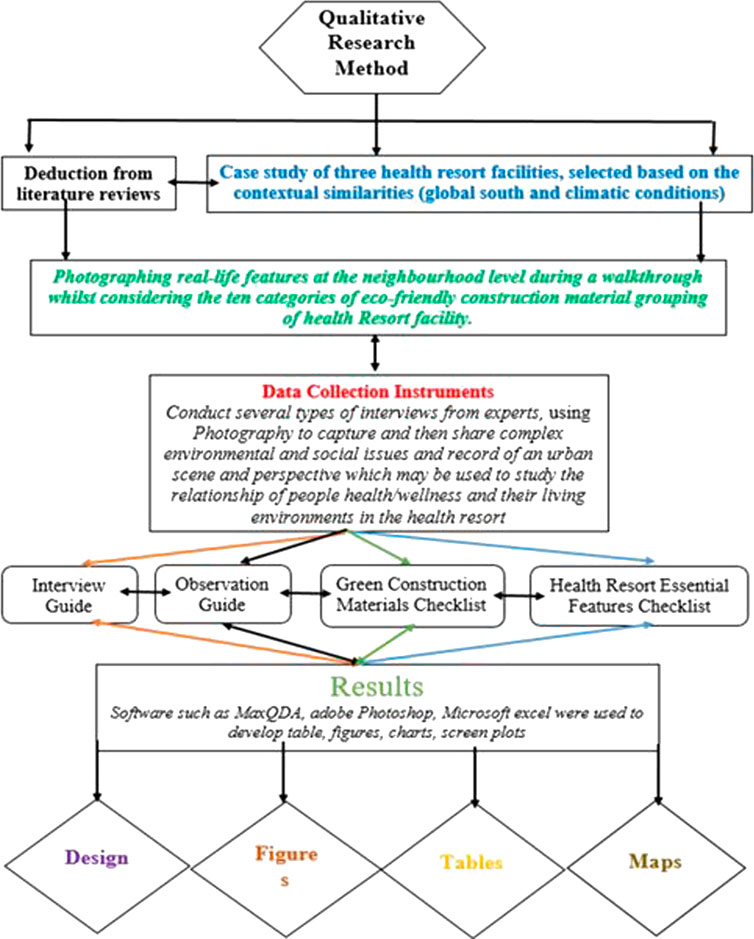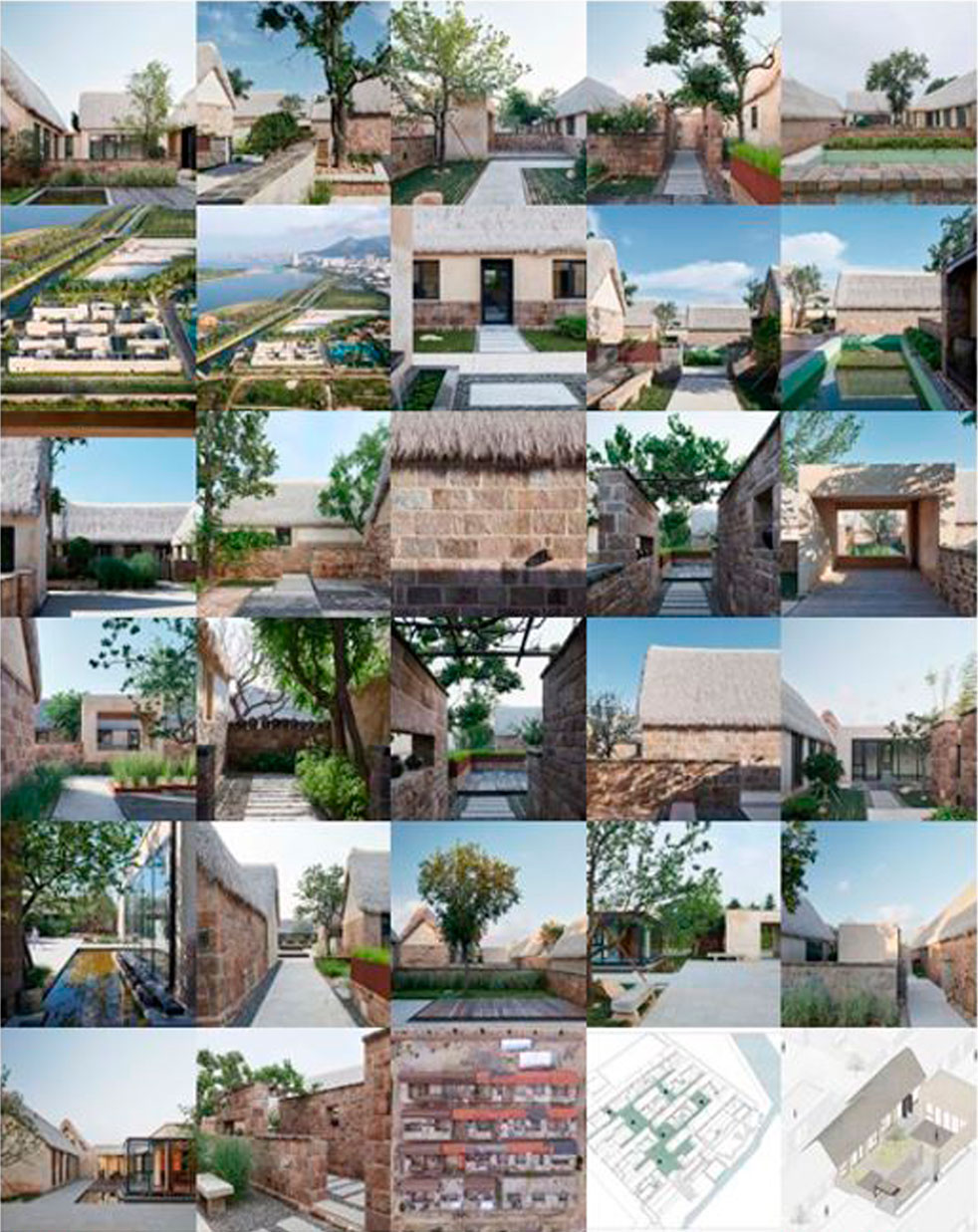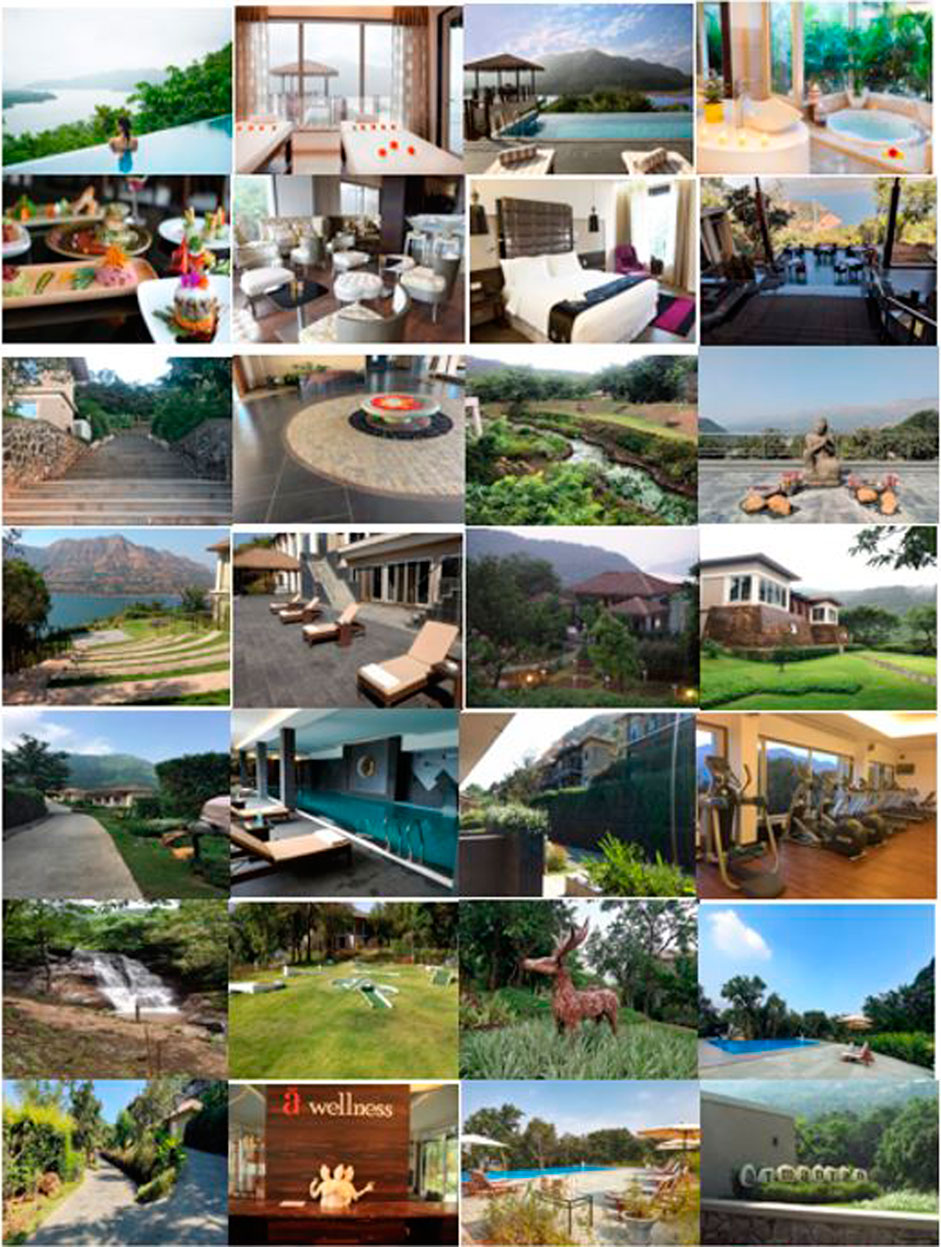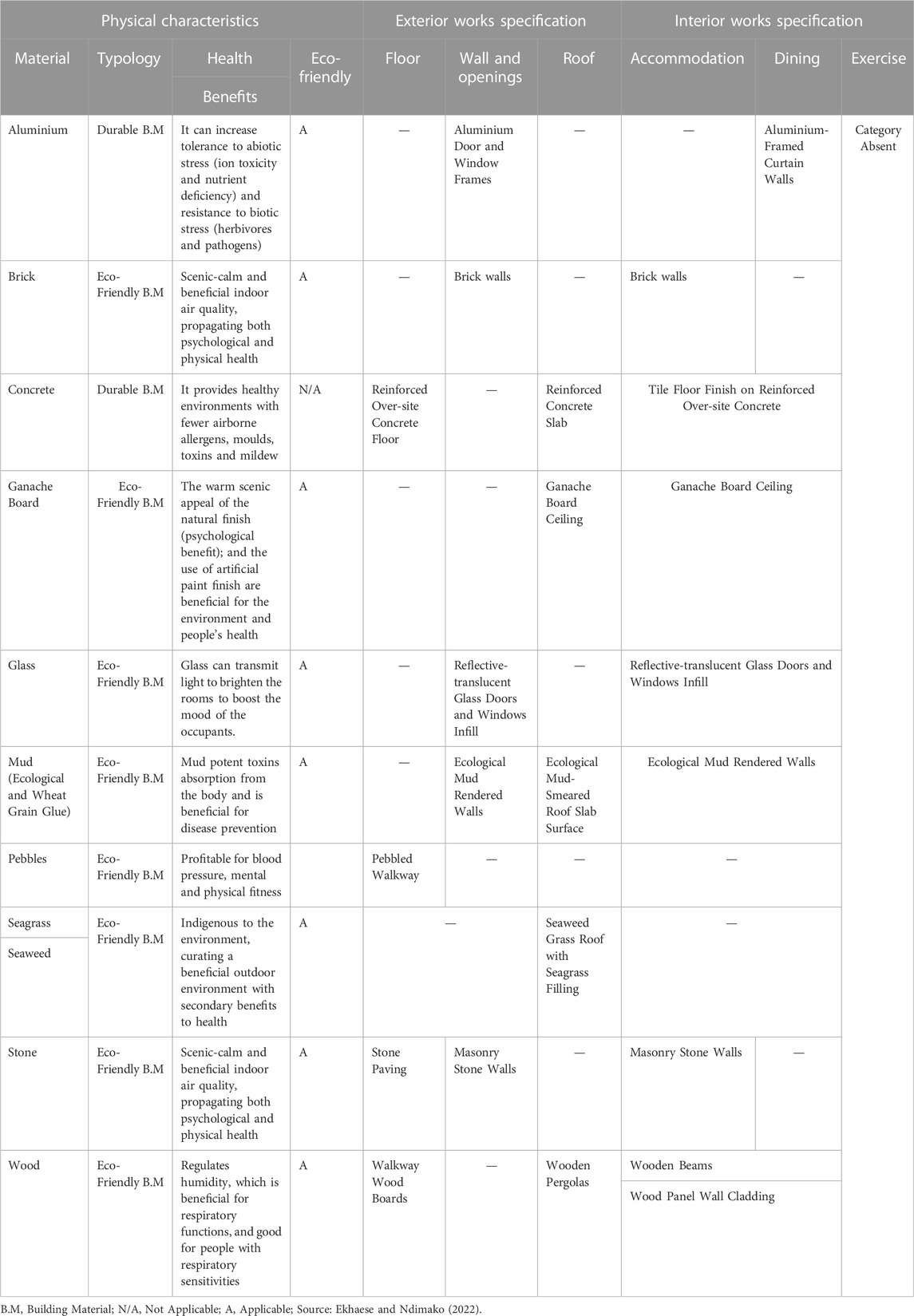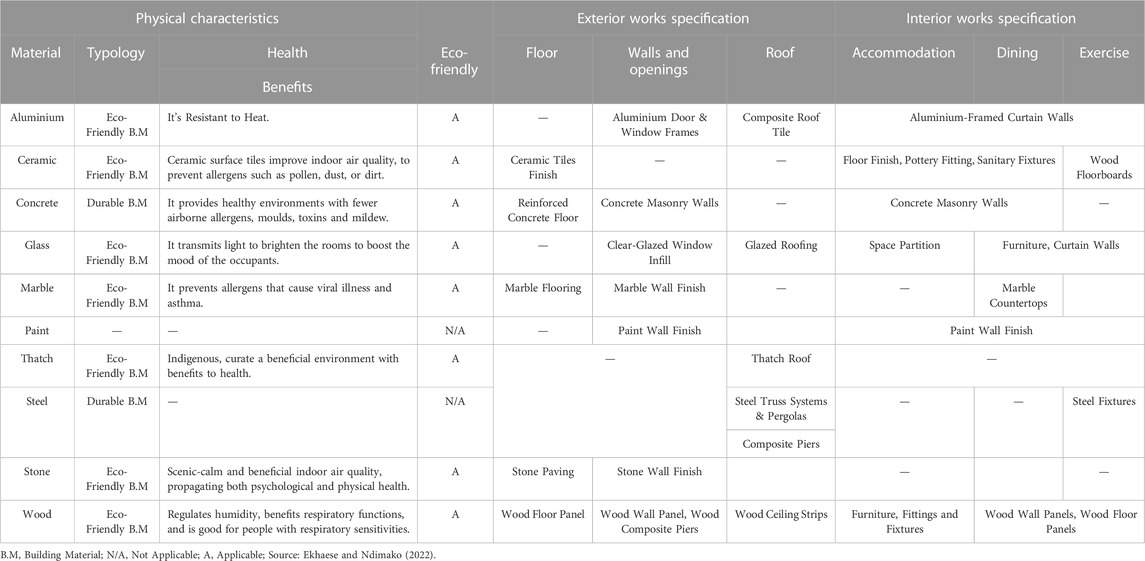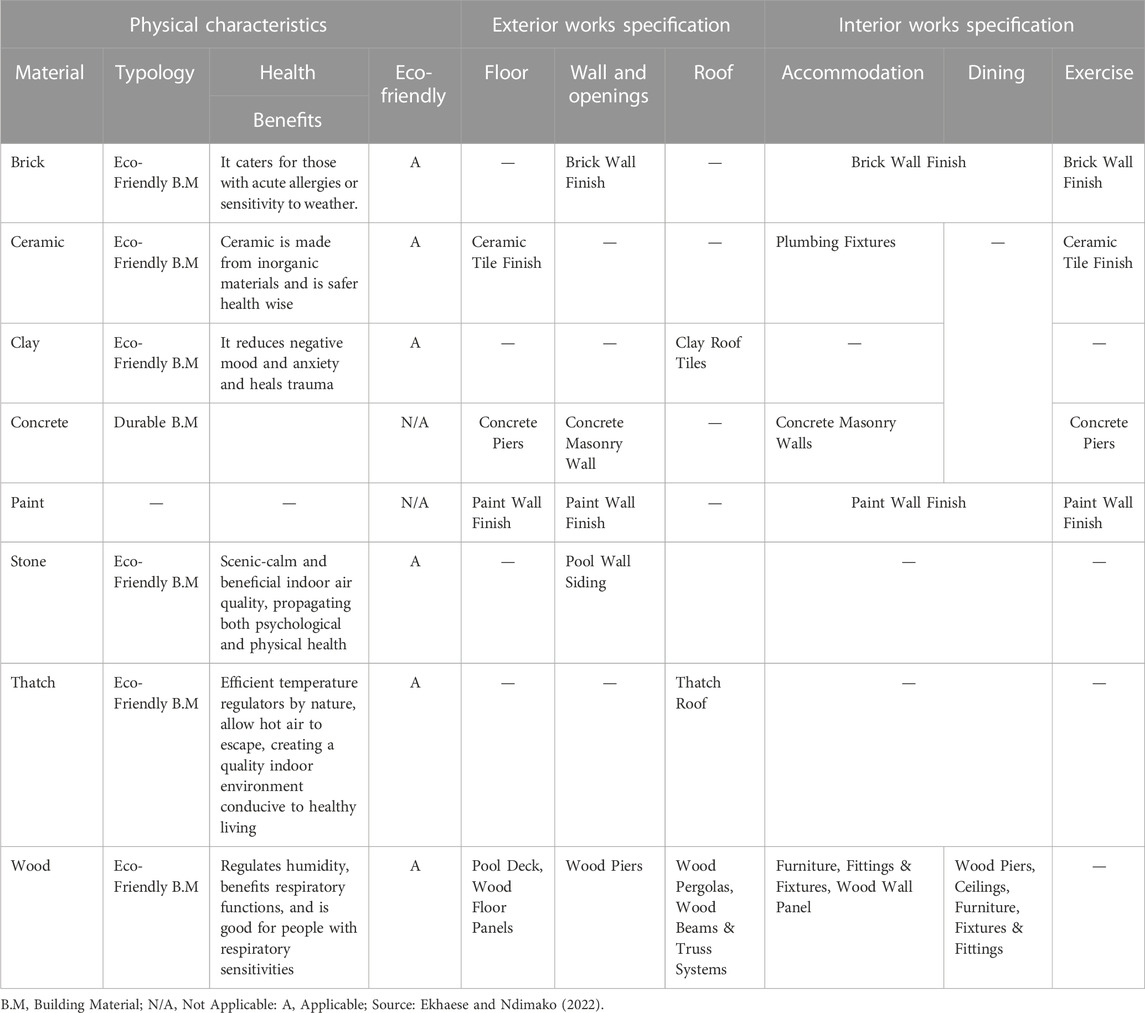- Department of Architecture, Covenant University, Ota, Ogun State, Nigeria
Health resort designs are health sanctuaries and a conducive treatment, healing, and wellness environment. In providing a health and wellness-beneficial environment, the material selection choices by health resort designers should conform to certain minimum specifications and standards. On this premise and SDG-based selection criteria, the study aims to investigate eco-friendly construction materials and their health benefits in an all-inclusive health resort design proposed for Port Harcourt, Nigeria. This study addressed three key objectives—Ascertaining the physical architectural features of health resorts, assessing the eco-friendly building material contribution to SDG attainment, and identifying the health benefits of eco-friendly building materials in the health resort. The researchers engaged the qualitative research method for the study, using a case study technique as a qualitative research design/strategy. The authors used three health resorts across three countries in the global south; China, India, and Brazil. The data collection instruments include; an in-depth interview guide In-depth Interviews (IDI), a direct observation guide, a checklist of green construction materials for health facilities and a qualitative photo-production study based on the essential features of a health resort checklist. The authors use content and narrative analyses to analyze data. Findings show that eco-friendly materials may be best suited for both exterior and interior works of health resort facilities. Wood, stone and concrete are the most preferred materials as they occur across all three case studies. The results align with current global trends towards eco-beneficial facilities. Adopting natural materials such as wood and stone for the Port Harcourt health resort would be expedient, given the health benefits inherent in using such eco-friendly materials and their alignment with the Sustainable Development Goals (SGD 11 and 13).
1 Introduction
Building materials impact the built environment and can influence health outcomes (Khoshnava et al., 2020). Eco-friendly building materials can affect individual health and has several health benefits. Recent research focuses on reducing carbon emissions and hitting Net Zero by 2050 (McGarry et al., 2022). Therefore, the building industry must meet sustainability targets by engaging in eco-friendly building materials and Eco-design amidst other choices to preserve the planet Earth (Wang et al., 2019). In construction, we use eco-friendly building materials in areas such as production and maintenance (Sivarethinamohan and Sujatha, 2021). Eco-friendly building materials are harmless to the environment in production, use or disposal and are easily recyclable (Abyzov et al., 2020, August). Using eco-friendly construction materials reduces carbon emissions, saves energy and is cost-effective. Eco-friendly building materials experienced a massive surge in 2020 due to the rise of sustainable construction. Examples of the top eco-friendly building materials include Bamboo, Straw Bales, Timercret, Recycled Plastics, Ferrock, Hempcrete and Cork (Mistri et al., 2020).
Healthcare buildings’ environmental impacts have raised questions such as: How best could we tackle outcomes on our environment? How can building outcomes be minimised in our environment? What are the best sustainable construction materials to mitigate the effects of buildings on our built environment? What are policies that can reduce the impact of building outcomes? (Omer and Noguchi, 2020). The link between building materials and human wellbeing is increasingly evident as moods and wellbeing are affected by various elements of the built environment as spatial allocations, lighting, access to nature, colour, indoor air quality, noise, thermal comfort, user control of space, and preferred settings. Sustainable building materials selection could significantly contribute to a healthy indoor environment and promotes wellbeing. Research has also alluded that a relationship exists between building material quality and human wellbeing (Lomas, 2019).
People living in healthy-built settings experience limited mental stress, like reduced anxiety and depression. Hence, the relevance of eco-friendly-building materials benefits within spaces. In building construction, materials gained early recognition (400 BC) as essential elements (Omer and Noguchi, 2020). Building materials exist as clay, sand, wood and stone or synthetic materials such as metal and plastics (Kubba, 2017). Thousands of building materials and products exist as metal and non-metal (Song et al., 2018). The construction industry is currently incorporating the sustainable concept into building material operations to limit building impact on the environment (Hoisington et al., 2019; Lundgren Kownacki et al., 2019). The choice of materials is of prime consideration in any design proposal. This study aims to select health resorts to determine appropriate eco-friendly construction materials and their health benefits for Port Harcourt health resort design. The questions include; what are the physical characteristics of the assessed health resorts? What are their exterior works specifications, and How are the materials employed in the space interior?
2 Literature review
According to Koduvayur Venkitaraman and Joshi, 2022, eco-friendly building materials contribute to healthier indoor spaces while enhancing the quality of the built environment. Promoting the choice of building material could prevent building users from long-duration illnesses such as cancer, lung ailments, central nervous system, and liver damage. Chronic diseases easily correlate with airborne harmful chemicals released from some building materials. Building materials with green features are considered environmentally sound, safe, non-toxic and non-radioactive (Chan et al., 2021). These materials selection over other materials will promote a healthy environment for humans and reduce the adverse building outcomes inbuilt settings. Buildings contribute significantly to attaining specific SDGs (Cucuzzella et al., 2021).
Alawneh et al., 2018; Hurlimann et al., 2019 explained that local and global challenges such as climate change, health and wellbeing affect the building material industry. Research reveals that efficient and responsible choices and building materials strategies are vital for built settings to contribute significantly to preserving biodiversity and realising the SDGs (Omer and Noguchi, 2020). The demand for eco-friendly building materials has grown dramatically over the past few years. And it is projected to drive the building materials industry and construction growth future. It may also have indirect contributions to health. For instance, eco-friendly building materials choices like clay, gravel, lime, sand, wood, et cetera can contribute to ending some forms of poverty. When eco-friendly building materials are applied efficiently, construction costs can reduce to 60% (Ugochukwu and Chioma, 2015). Eco-friendly building materials can mitigate the impact of buildings on global greenhouse gas emissions and other climate-related hazards (Huang et al., 2019).
Fei et al. (2021) explained that building materials correlate with achieving 13 of the 17 SDGs and 25 UN 2030 Agenda targets. Over four (4) billion people live in cities at a 73 million per annum growth rate. Urban areas account for about three-quarters of the world’s gross domestic product. Therefore, the built environment must become relevant to impact a large population globally. The construction industry plays a vital role in achieving sustainable cities and communities—SDG 11 (Fei et al., 2021). Relating to SDG 3 (health and wellbeing), studies show that increased sensitisation on healthy and non-toxic building materials should be considered a priority to achieve global health and wellbeing and other SDGs. Research has shown that urban regenerating endeavours could significantly aid the realisation of SDG 11 (sustainable cities and communities), SDG 7 (affordable and clean energy), SDG 6 (clean water and sanitation) and SDG 1 (end poverty). The built environment has impacted the health, quality of life, wealth, wellbeing and happiness of individuals and communities concerning built asset planning, design, maintenance, and management. Hence, the need to predetermine construction materials suitable for the first health resort development in Port Harcourt, Nigeria.
3 Materials and methods
The researchers engaged the qualitative research method. The study uses the case study technique as the research design/strategy. The data collection instruments were; an in-depth interview guide (IDI), a direct observation guide, a checklist of green construction materials for health facilities and a qualitative photo-production study based on the Checklist of Essential Features of a health resort. The author used content and narrative analyses to analyze data, as shown in Figure 1. The authors collected data through a review of relevant literature, a case study of health resorts and interviews with experts on eco-friendly building materials and their health benefits in a health resort. The researchers selected three (3) health resorts based on established measurement criteria. The researcher used a visual research method (photo-production method) to analyse the data collected from the three case studies of health resorts based on the essential architectural features and eco-friendly building materials. The authors further developed a building-materials contribution toward SDGs achievement and related targets. The authors selected the three case studies based on the contextual similarities—facilities had to be situated within the global south and with similar climatic conditions as the humid tropical region of Port Harcourt, Nigeria. The three case study facilities selected are Seaweed Bay Health Resort (Weihai, China), Atmantan Wellness Centre (Maharashtra, India) and Salinas Maragogi (Maragogi, Brazil).
3.1 Study location
Port Harcourt is a prominent colonial city in the south-south geo-political region of Nigeria, as shown in Figure 2. With a fast rate of growth and increasing urbanisation, the city is grappling the realities of unhealthy and horrid urban spaces such as slums and illegal developments (a threat to SDGs 3, 6, 14, and 15). In response to this, the government has since 2015 embarked on urban renewal endeavours to restore the capital city to its afore-known garden status. A key strategy in achieving this goal is to develop infrastructure that will bring about beneficial health outcomes. Park Port Harcourt and Mother and Child Hospital, among other health-living-based investments, highlight the Rivers state government’s provisions in ensuring a healthy citizenry. Given the design of a health resort for Port Harcourt city, it is necessary to conduct a case study of existing health resort facilities in several locations of the world, especially concerning materials used for construction. It is to ensure a conducive and sustainable environment in the proposed facility to foster beneficial health outcomes for the over three million citizens of the city. Healthy buildings support social, mental, and physical wellbeing. They likewise reinforce physical health by their structural stability, efficient shelter from the elements, excess moisture prevention, comfortable temperatures facilitation, efficient sanitary condition and adequate illumination, sufficient space, clean/safe power supply, pollutants protection, injury hazards and pests preclusion (World Health Organization, 2018). Many of these qualities are material-dependent.
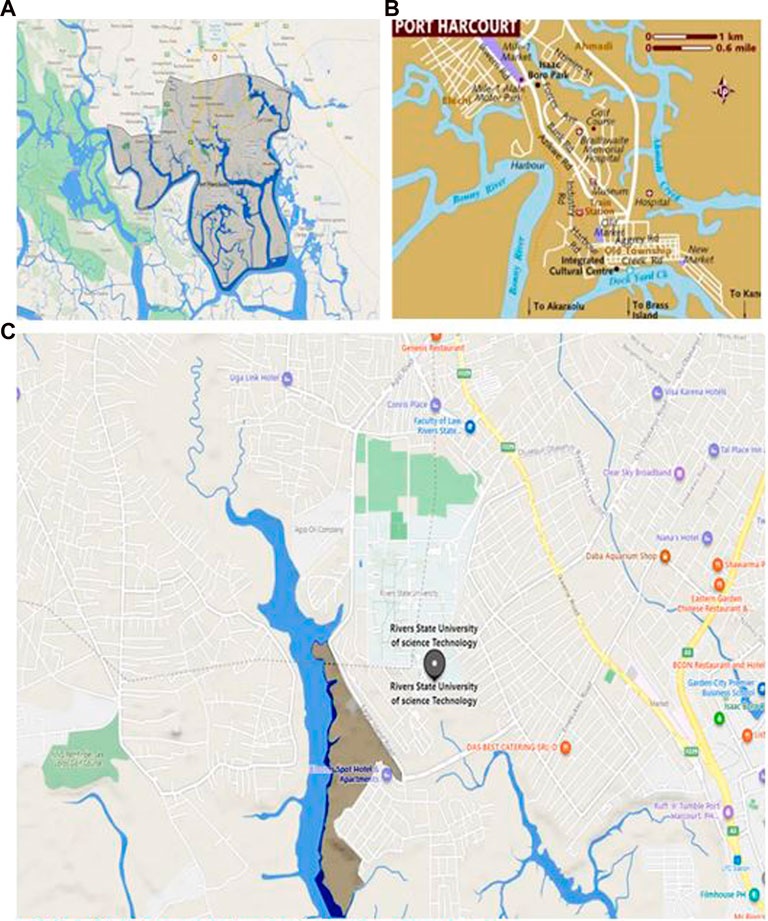
FIGURE 2. (A) Map of Port Harcourt showing the local government areas; (B) Map of Port Harcourt showing the old township and the core area in the city; (C) Map of the proposed site along Eagle island Road by Blooms Spot hotels and apartments. Source: Ekhaese and Ndimako (2022).
3.2 Data collection
The research focuses on expert (professional) opinions of the Built Environment Professionals (BEPs), Health and Medical professionals (HMPs), and environmentalists across Nigerian universities to validate the authors’ expectations on the health benefits of eco-friendly construction materials used in a health resort. The authors conducted In-depth Interviews (IDI) with twelve (12) experts/professionals drawn from four (4) BEPs, four (4) HMPs and two (2) Environmentalists and two (2) Therapeutic Architects across universities in Nigeria, as shown in Table 1. The researchers did not conduct in-depth interviews within the three case studies. However, the authors purposively selected participants (experts) from academics from Nigerian universities. In the use of documentary analysis and interviews, the interview exercise covered 120 h for the study (i.e., 10 h per day for 12 days) with each university don. The authors employed two (2) research assistants for the exercise to cover Port Harcourt without Lagos, which the authors covered. Data collection (interviews) procedures took place between June 30 and 15 July 2021.
The research used a visual research method (photo-production method) as part of the study. Photograph assists participants in telling a story through images. Images provide an enduring record of a scene and perception to study the relationship between people and their living environments. A photograph allows intricate environmental and social issues to be captured and shared. This study aims to highlight the essential features of a health resort visible in the photos. This study used thesnapping features approach of the selected case study health resort whilst considering materials grouping based on the building-materials contribution framework toward SDGs achievement. The health resort essential features checklist was used, considering the health benefits of a health resort. Assessments of these features rely on International Classification. Photos were made in June and July 2021 by two (2) research assistants and the co-author, who received instructions from the principal investigators to cover each case study via the internet and correspondents from the three different countries of China, India and Brazil. The guideline was for research assistants to take pictures based on the checklist of essential features of a health resort. Also, the authors conducted in-depth interviews with experts on several issues, with extracts on the health benefits of Eco-friendly construction materials for users of a health resort presented through direct quotes.
3.3 Ethics
During the survey data collection process, the research assistants capture no explicit photographs of people. This aspect did not involve direct participation. However, obtaining ethical approval and informed consent was not necessary from the institutional ethics committee since the experts for the in-depth interview were colleagues from the university.
3.4 Data analyses
The researchers employed the health resort essential features checklist for the primary data analyses (a priori thematic analysis). There were 30 photographs in Seaweed Bay Health Resort, Weihai, China, 28 in Atmantan Wellness Centre, Maharashtra, India and 27 in Salinas Maragogi, Maragogi, Brazil as shown in Figures 4, 5 and 6. The authors achieved data saturation for every case study. Photographs were clustered based on the domains of the checklist, and the stories relating to these photos were to describe the eco-friendly building material and its health benefits. After collecting the photographs data, the authors presented the pictures to the interviewed experts/professionals as a form of check and validation. Also, design aspects of the built environment (architecture and urban planning) were analysed using photos to see if health resort features are eco-friendly and have health benefits for users. We developed observational notes and transcribed and analysed them using thematic analysis. The authors deductively coded the transcripts under a pre-existing theme; “Health Benefits of Eco-Friendly Construction Materials used in a Health Resort.” The authors presented the participants construct of their experiences in the subject matter through direct quotes and ethnographic synopses.
4 Results and discussion
The construction industry also presents a challenge since there are innovations to explore and identify eco-friendly building materials that are less dangerous to the environment and enhance human health every year (Dirisu et al., 2022). The finding indicates that the data analysis relies on the research objectives presented. The assessment technique for qualitative data relies on research objectives, methodology, and analysis. Therefore, the research objectives include: identifying the physical characteristics of the selected health resorts, ascertaining their exterior works specifications and examining the health benefits of building materials employed in the interior spaces. However, the authors presented results in sequential order of the study objectives.
4.1 The result of ascertaining the physical architectural features in a health resort
Figure 3 presents the essential architectural feature of a health resort checklist as: Medicals (treatments), Spa and Beauty (Bath, beauty, care message), Fitness (gym, yoga studios, hydro-therapy), Sports (tennis court, swimming, golf course, sky), Nature (Parks, garden, lakes, pool, ocean access), Education (aquarium, zoo, museum, classrooms), Community (heritage, social connectedness), Nutrition (healthy local food) that guide the photoproduction process. Three markers drive the essential features of a health resort- 1. Pleasure and Wellbeing (medicals, spa and beauty and Fitness), 2. Healing experience (Sports, nature and education) and 3 Community engagement (Nutrition, Community and education).
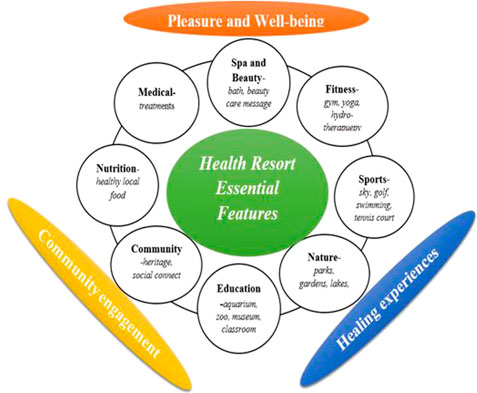
FIGURE 3. List of essential features/facilities of health resort; Source: Ekhaese and Ndimako (2022).
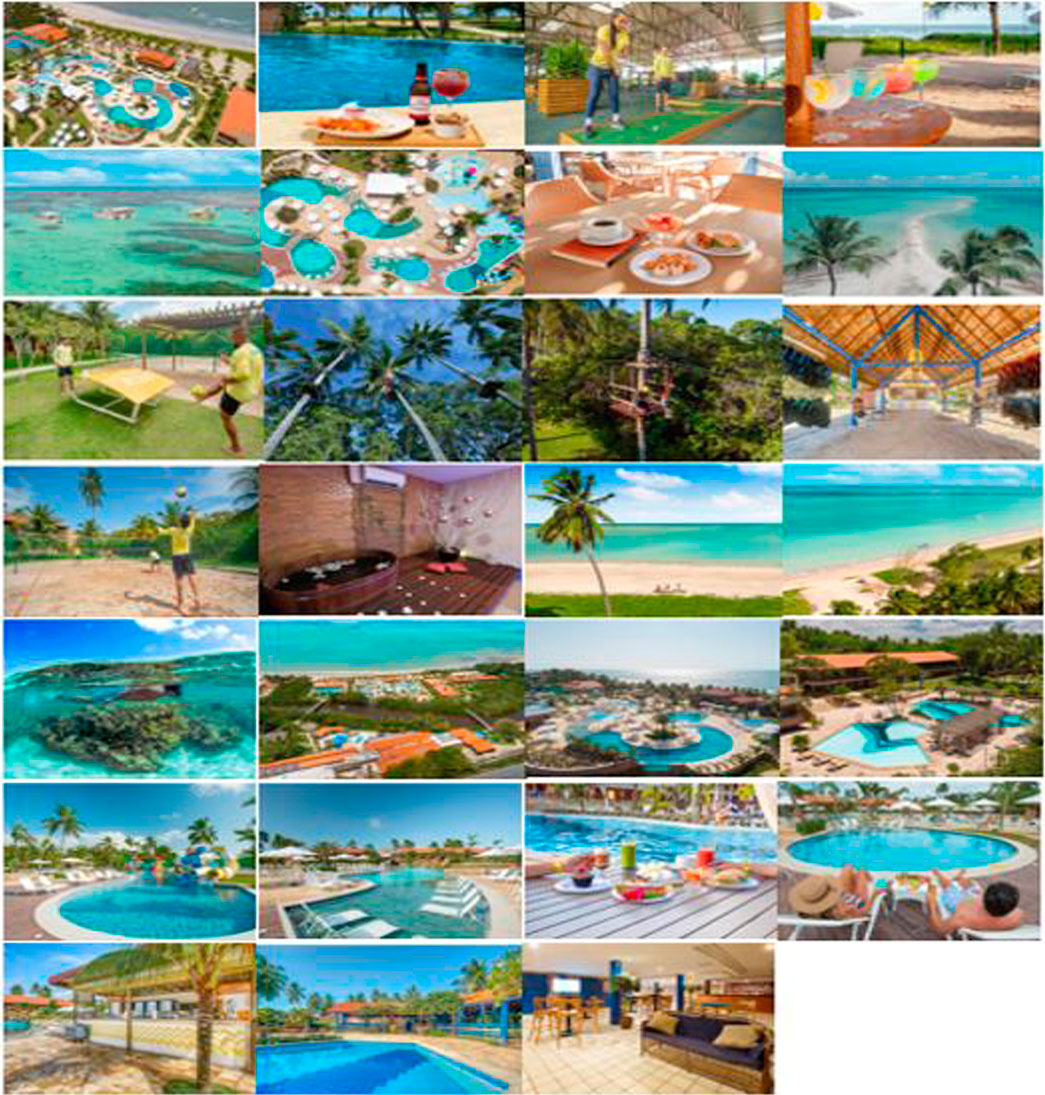
FIGURE 6. Photoproduction of Salinas Maragogi health resort, Brazil; Source: Ekhaese and Ndimako (2022).
The authors conducted In-depth Interviews (IDI) with twelve (12) experts drawn across Universities in Nigeria. The health benefits derived from using eco-friendly construction materials in a health resort facility from literature and corroborated by professionals include; longevity, comfort, improved health and wellness, environmental protection, waste minimization, better quality of life, and noise avoidance (Han et al., 2020; Raouf and Al-Ghamdi, 2020; Sohaib, Wang, Iqbal and Han, 2022).
According to CO., a molecular plant systemist and biostatistician,
“Eco-friendliness is about longevity. Hence, we design eco-friendly buildings to last for a long time. Many eco-friendly construction materials are robust, low maintenance, and provide long-term environmental benefits such as better insulation. Timber, for example, is highly durable depending on the wood used, and can be treated further to limit fungal decay or provide enhanced fire protection and enhance users’ health.”
However, from the photoproduction of the three case study facilities selected that facilitate user health benefits as presented in case studies 1, 2, and 3 below, timber and a thatched roof as eco-friendly construction materials to enhance the health of the Seaweed Bay Health resort users;
Case study 1: Seaweed Bay Health Resort Rongcheng City, Weihai City, Shandong Province, China.
Case study 2: Atmantan Wellness Centre Village Palse, Tamhini Ghat Rd, Mulshi, Maharashtra India.
Case Study 3: Salinas Maragogi Rodovia AL-101 Norte Km 124 s/n Sitio Carió, Maragogi—AL, Brazil.
4.2 The result of eco-friendly building material contribution to SDG attainment of the selected health resorts
Table 2 show Eco-Friendly building or construction materials. It explains the material type, the building/construction materials description, empirical supports and the construction material sample.
In relating Table 3 to eco-friendly construction materials selection for the design of a health resort, there are two main areas of relevance, the health implications and the environmental impacts. The study references building material examples relating to human health and the environment. It implies that the material typology reflected under SDGs 3, 11, 12 and 13 are connections to human health (SDG 3) and the environment (SDGs 11, 12, and 13), as shown in Table 3. However, all identified eco-friendly material typologies influence the attainment of all four SDGs (3, 11, 12, and 13). It is on the hypothesis that, for a built environment to be highly beneficial to residents’ health and support a healthy/safe environment, the material composition should ideally be Eco-Friendly, Responsibly Sourced Building Materials.
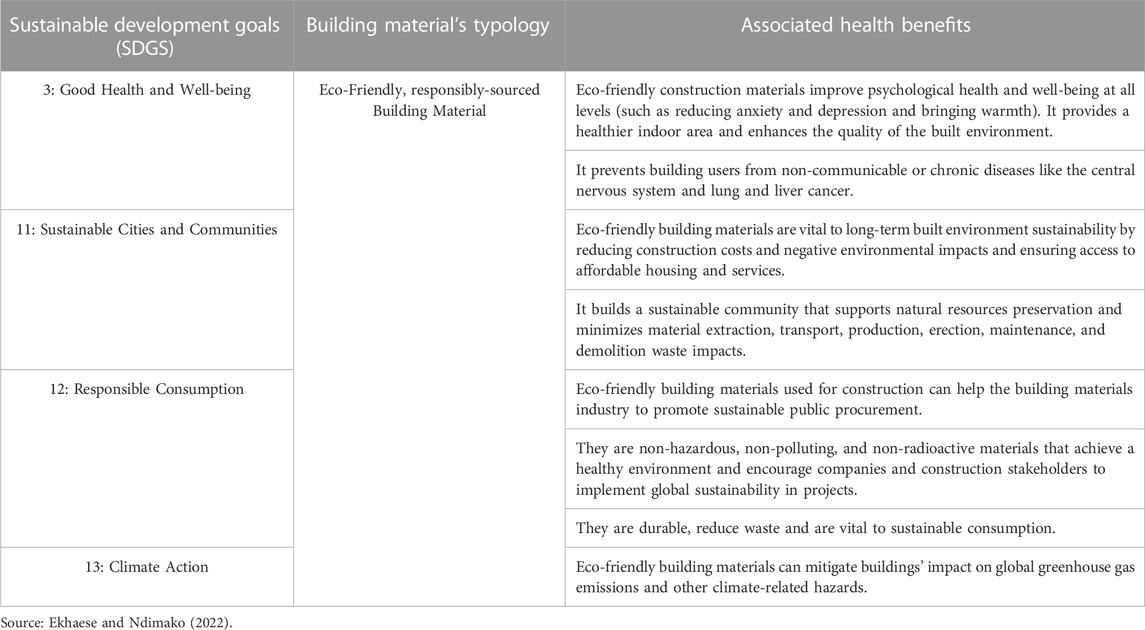
TABLE 3. Eco-friendly building materials contribution toward SDGs’ attainment and their health benefits.
A healthy people and environment are vital SDG targets, which is suggestive of the above framework that the material selection for any building development should include all building material typologies in their applications. It is ideal, though evidence from the facilities assessed shows that all material typologies may not be available. However, the percentage of materials composing a facility falls within the eco-friendly building material typology (Table 2). More so, when a facility is developed with the specific intention to foster health (as is the case with health resorts), it is expected that greater attention is to materials typologies included in the fabric of the facility. As earlier identified, the referenced framework suggests that for the SDGs of Good Health and Wellbeing, Sustainable Cities and Communities, Responsible Consumption and Climate Action, at the very least eco-friendly building material should make up the material selection for a health-based facility such as a health resort. It is the case observed in three selected facilities. However, the emphasis is on the facilities scenery to improve the health benefit of occupants and the environment. The Sea Bay Health Resort and Salinas Maragogi Resorts were composed of better health and eco-friendly construction materials since most of their material fabric is eco-friendly responsibly-sourced building materials. Applying this knowledge as a guide for decision-makers in the design process for the health resort in Port Harcourt (Nigeria), the materials choices must comprise eco-friendly responsibly-sourced building materials. This typology should serve as the dominant materials, while other material typologies can make up other requisite components.
4.3 Result of identifying the health benefits of eco-friendly construction materials used in a health resort
Eco-friendly construction involves materials uses and processes that are resource-efficient and environmentally responsible throughout the life cycle of a building (Singh, 2018). Eco-friendly building materials have seen a surge in popularity due to the several benefits over non-eco-friendly building material that ranges from environmental to social and health and wellness (Fu et al., 2021; Zitars et al., 2021).
In an interview with ONE, a therapeutic architect and urban health influencer,
“Buildings created using eco-friendly materials can be more comfortable to spend time on. That’s because sustainable constructions often maximise natural light to limit reliance on electricity. Eco-friendly materials also provide greater acoustic and thermal comfort because they are highly efficient insulators. In the end, it is beneficial to the users health.”
SC, a life scientist and researcher, said in an interview that
“the buildings we spend time inside can significantly impact our health. Some construction materials release harmful toxins like carcinogens. Timber and other eco-friendly options do not. Instead, studies have shown they reduce stress and anxiety and nurture more positive social interactions. There is even evidence to suggest that timber can lower blood pressure.”
Eco-friendly construction is not about building creation with a low environmental impact. It is an innovative approach to building design that improves people’s health and lifestyle and how they construct (Balali et al., 2020; Prakash et al., 2020).
LA, a building material and health expert, said; “Eco-friendly construction materials can be beneficial to health. According to the Environmental Protection Agency, outdoor air is two to five times less polluted than indoor air. Synthetic building and furnishing materials can be dangerous for human health. Therefore, eco-friendly construction materials like the ones listed in Table 4 below (aluminium, brick, concrete, ganache board, glass, mud, pebbles, seagrass, seaweed, stone and wood) used indoors of the health resort can help to purify the air.”
Material compositions of the case study facilities range from durable and eco-friendly, responsibly sourced building material typologies. The Sea Bay Health Resort and Salinas Maragogi designs are a mix of; durable and eco-friendly responsibly sourced building materials, as shown in Table 4.
The character of the facilities depicts an affinity for nature and a serene setting. The material specifications possess renewable qualities with low negative environmental impacts and potential for occupants. They are known to be healthy and do not release toxins encouraging safe environments and people. Atmantan Wellness Centre, though situated in the natural scenery of mountains and lakes, is of durable material typology and the more favourable Eco-Friendly responsibly-sourced Building Materials.
For Tables 4–6, the authors described material typology classification in all cases (tables). In the context of the definitions for various building material typologies, no material typology is 100% void of negative impact on the environment since all materials undergo engineering before being used as construction materials. Therefore, the classification focuses on their impact on the environment and their life cycle impact, especially concerning construction and use/maintenance. However, addressing particular building materials requires appropriate cognisance of the research context (Nigeria). Aluminium is a commonly used construction material in this geographical context. All material typologies are subject to those readily sourced in the geographical location and eco-friendly. The climatic context is also a consideration for defining the kind of materials studied (Nigeria is in the tropical region). Again, the cultural context of buildings located in the global south—culture choices as a factor in the material choice for building construction, especially for the architectural typology under investigation (health resorts). These considerations were relevant in the case studies’ selection process for this research. Hence, Brazil, China and India selection as case studies. Wood is regarded under typology as “responsibly sourced building material” because of the legal process. The authors present the use of seaweed and seagrass as the roof system, particularly in the Seaweed health resort. It represents a typical case of using naturally sourced materials engineered by traditionally developed techniques (which may reduce carbon footprint as a benefit inherent in the material).
This was properly situated when, FD, a senior lecturer and construction expert, said
“Recycled (eco-friendly) construction materials used during the construction contribute significantly to environmental protection and waste reduction. Moreover, eco-friendly construction takes into serious consideration several critical elements. The well-insulated windows, ceilings and wall installation ensure that no energy is going to waste. Also, more responsibly sourced building materials can be less harmful to the health resort environment.”
GO, a biochemist and environmental health expert, said:
“The construction industry is responsible for half of the global waste. Eco-friendly construction materials minimize waste with their lower environmental impact and the use of renewable sources and materials.”
The health benefits classification of eco-friendly construction materials is into environmental, financial and social health benefits, as shown in the three cases (Han et al., 2020; Bangwal et al., 2022).
LO, an architect and urban designer, said
“Eco-friendly construction material has several benefits in every stage of a construction project. Improved health due to safer materials, increased productivity because of better surroundings, and more effective noise protection are only a few advantages. Eco-friendly building materials can improve life quality.”
AA, a senior research and environmental management expert said
“Noise can have a significant effect on a person’s wellbeing. Eco-friendly construction may put extra attention to noise avoidance through eco-friendly construction materials as noise absorbers and creating noise barriers to enhance the users of the health resort facility.”
5 Conclusion
Researchers study construction materials to minimise the cost of raw materials and improve the quality of the product (Dirisu et al., 2022). Buildings are the foundations of cities and communities, so building materials are vital to long-term sustainability. Sourcing building materials should be with consideration for minimal negative impacts on the environment and the health of its people. Eco-friendly building materials influence the actualisation of the United Nations’ sustainable development goals (UN SDGs). The UN SDGs are towards improved Quality of Life and healthy/safe environments. Several materials’ empirical works have established links between eco-friendly building materials and eco-design contributions to healthy/safe environments and the resident’s quality of life across various localities. In establishing this connection, the buildings material composition is of primary relevance. Hence, this study assessed a Health Resort facilities case study to determine the best eco-friendly construction material choices for a health resort in Port Harcourt, Nigeria. Since SDGs’ target today is reducing carbon emissions, stopping global warming and hitting Net Zero by 2050, the eco-friendly building material, construction and eco-design must be at issue in the built environment. Buildings must be eco-friendly (i.e., reusable and offer decent indoor environments) and aid the actualisation of the SDGs. An implication for further study includes- scientific tests and a quantitative assessment to determine the exact materials selected for the Port Harcourt health resort. The scope has been limited to qualitative materials assessments to get a general overview of what is obtainable for such a building design.
Data availability statement
The original contributions presented in the study are included in the article/Supplementary Material, further inquiries can be directed to the corresponding author.
Author contributions
ON: Resources, investigation, visualization and data curation, EE: Conceptualization, data curation, formal analysis, investigation, methodology, supervision, validation, project administration and data curation, project administration, resources, visualization, writing—original draft, writing—review and editing.
Acknowledgments
The author sincerely appreciates Covenant University’s financial assistance in publishing this article. We are indeed grateful for the opportunity to do this research. The authors appreciate all contributors, patients and experts who provided data for the study. For EE, who validated the results, prepared and wrote the initial draft and also supervised the work, conceptualisation of the ideas, research aim and objective, development or design of methodology, project administration, research supervision, final writing and collation of all sections of the paper together. Also, special appreciation to ON for his involvement in the literature reviews; his valuable contribution to conducting and investigating the data collection. In conclusion, the authors have taken every error and omission in this paper as their responsibility.
Conflict of interest
The authors declare that the research was conducted in the absence of any commercial or financial relationships that could be construed as a potential conflict of interest.
Publisher’s note
All claims expressed in this article are solely those of the authors and do not necessarily represent those of their affiliated organizations, or those of the publisher, the editors and the reviewers. Any product that may be evaluated in this article, or claim that may be made by its manufacturer, is not guaranteed or endorsed by the publisher.
Supplementary material
The Supplementary Material for this article can be found online at: https://www.frontiersin.org/articles/10.3389/fbuil.2023.1011759/full#supplementary-material
References
Abyzov, V. A., Pushkarova, K. K., Kochevykh, M. O., Honchar, O. A., and Bazeliuk, N. L. (2020). “Innovative building materials in creation an architectural environment,” in IOP Conference Series: Materials Science and Engineering (Gothenburg, Sweden: IOP Publishing), 012035. 907. doi:10.1088/1757-899X/907/1/012035
Ahmad, M., and Rashid, K. (2022). Novel approach to synthesize clay-based geopolymer brick: Optimizing molding pressure and precursors’ proportioning. Constr. Build. Mater. 322, 126472. doi:10.1016/J.CONBUILDMAT.2022.126472
Alawneh, R., Mohamed Ghazali, F. E., Ali, H., and Asif, M. (2018). Assessing the contribution of water and energy efficiency in green buildings to achieve United Nations Sustainable Development Goals in Jordan. Build. Environ. 146, 119–132. doi:10.1016/J.BUILDENV.2018.09.043
Amran, M., Debbarma, S., and Ozbakkaloglu, T. (2021). Fly ash-based eco-friendly geopolymer concrete: A critical review of the long-term durability properties. Constr. Build. Mater. 270, 121857. doi:10.1016/J.CONBUILDMAT.2020.121857
Balali, A., Valipour, A., Zavadskas, E. K., and Turskis, Z. (2020). Multi-criteria ranking of green materials according to the goals of sustainable development. Sustainability 12 (22), 9482. doi:10.3390/su12229482
Bangwal, D., Suyal, J., and Kumar, R. (2022). Hotel building design, occupants’ health and performance in response to COVID-19. Int. J. Hosp. Manag. 103, 103212. doi:10.1016/j.ijhm.2022.103212
Behl, V., Singh, V., Dahiya, V., and Kumar, A. (2022). Characterization of Physico-chemical and functional properties of fly ash concrete mix. Mater. Today Proc. 50, 941–945. doi:10.1016/j.matpr.2021.06.353
Cabeza, L. F., Boquera, L., Chàfer, M., and Vérez, D. (2021). Embodied energy and embodied carbon of structural building materials: Worldwide progress and barriers through literature map analysis. Energy Build. 231, 110612. doi:10.1016/J.ENBUILD.2020.110612
Chan, P., Khoeng, K., Ung, H. K., Tang, T., Eung, K., Uth, S., et al. (2021). Plan-design, construction, performance, and renovation criteria for sustainable buildings: Data review. doi:10.20944/preprints202108.0295.v1
Chen, C. X., Pierobon, F., Jones, S., Maples, I., Gong, Y., and Ganguly, I. (2021). Comparative life cycle assessment of mass timber and concrete residential buildings: A case study in China. Sustainability 14 (1), 144. doi:10.3390/SU14010144
Cucuzzella, C., Hazbei, M., and Goubran, S. (2021). Activating data through eco-didactic design in the public realm: Enabling sustainable development in cities. Sustainability 13 (8), 4577. doi:10.3390/su13084577
Dirisu, J., Joseph, O., Babalola, P. O., Oyedepo, S. O., Fayomi, O. S. I., Oluwasegun, K. M., et al. (2022). Utilization of waste materials for eco-friendly building ceilings: An overview. Key Eng. Mater. 917, 285–295. doi:10.4028/p-1i2y29
Dirisu, J. O., Oyedepo, S. O., Fayomi, O. S. I., Joseph, O. O., Akinlabi, E. T., Babalola, P. O., et al. (2022). Thermal-emission assessment of building ceilings from agro-industrial wastes. Fuel Commun. 10, 100042. doi:10.1016/j.jfueco.2021.100042
Fei, W., Opoku, A., Agyekum, K., Oppon, J. A., Ahmed, V., Chen, C., et al. (2021). The critical role of the construction industry in achieving the sustainable development goals (SDGs): Delivering projects for the common Good. Sustainability 13 (16), 9112. doi:10.3390/SU13169112
Fu, Y., Wang, H., Sun, W., and Zhang, X. (2021). New dimension to green buildings: Turning green into occupant well-being. Buildings 11 (11), 534. doi:10.3390/buildings11110534
Garay, R., Pfenniger, F., Castillo, M., and Fritz, C. (2021). Quality and sustainability indicators of the prefabricated wood housing industry—a Chilean case study. Sustainability 13 (15), 8523. doi:10.3390/SU13158523
Goldhahn, C., Cabane, E., and Chanana, M. (2021). Sustainability in wood materials science: An opinion about current material development techniques and the end of lifetime perspectives. Philosophical Trans. R. Soc. A, 379, 20200339. doi:10.1098/RSTA.2020.0339
Han, H., Quan, W., Lho, L. H., and Yu, J. (2020). Eco-design of airport buildings and customer responses and behaviors: Uncovering the role of biospheric value, reputation, and subjective well-being. Sustainability 12 (23), 10059. doi:10.3390/su122310059
Han, H., Yu, J., and Hyun, S. S. (2020). Effects of nature-based solutions (NBS) on eco-friendly hotel guests’ mental health perceptions, satisfaction, switching barriers, and revisit intentions. J. Hosp. Mark. Manag. 29 (5), 592–611. doi:10.1080/19368623.2019.1660751
Hashmi, A. F., Shariq, M., and Baqi, A. (2021). An investigation into age-dependent strength, elastic modulus and deflection of low calcium fly ash concrete for sustainable construction. Constr. Build. Mater. 283, 122772. doi:10.1016/J.CONBUILDMAT.2021.122772
Hoisington, A. J., Stearns-Yoder, K. A., Schuldt, S. J., Beemer, C. J., Maestre, J. P., Kinney, K. A., et al. (2019). Ten questions concerning the built environment and mental health. Build. Environ. 155, 58–69. doi:10.1016/J.BUILDENV.2019.03.036
Huang, B., Chen, Y., Mcdowall, W., Türkeli, S., Bleischwitz, R., and Geng, Y. (2019). Embodied GHG emissions of building materials in Shanghai. J. Clean. Prod. 210, 777–785. doi:10.1016/j.jclepro.2018.11.030
Hurlimann, A. C., Warren-Myers, G., and Browne, G. R. (2019). Is the Australian construction industry prepared for climate change? Build. Environ. 153, 128–137. doi:10.1016/J.BUILDENV.2019.02.008
Jagatramka, R., and Prasad, R. (2022). Mud jaalis of surguja: A tribal narrative from Chhattisgarh. Mater. Today Proc. 60, 541–544. doi:10.1016/j.matpr.2022.01.432
Jain, G., Singh, M., and Sarkar, S. (2022). Development of a framework for assessing energy efficiency of the alternative construction techniques in the housing sector. ECS Trans. 107 (1), 11215–11224. doi:10.1149/10701.11215ecst
Khoshnava, S. M., Rostami, R., Mohamad Zin, R., Štreimikienė, D., Mardani, A., and Ismail, M. (2020). The role of green building materials in reducing environmental and human health impacts. Int. J. Environ. Res. Public Health 17 (7), 2589. doi:10.3390/ijerph17072589
Kilcline, K., Dhubháin, Á. N., Heanue, K., O’Donoghue, C., and Ryan, M. (2021). Addressing the challenge of wood mobilisation through a systemic innovation lens: The Irish forest sector innovation system. For. Policy Econ. 128, 102461. doi:10.1016/J.FORPOL.2021.102461
Koduvayur Venkitaraman, A., and Joshi, N. (2022). A critical examination of a community-led ecovillage initiative: A case of auroville, India. Clim. Action 1 (1), 15–19. doi:10.1007/s44168-022-00016-3
Kubba, S. (2017). Green building materials and products. Handb. Green Build. Des. Constr. 257–351. doi:10.1016/B978-0-12-810433-0.00006-X
Lee, B. X. Y., Ponraj, M., Widyasamratri, H., and Wang, J. (2021). Green building practices on waste minimization in China construction industry. Industrial Domest. Waste Manag. 1 (1), 12–25. doi:10.53623/idwm.v1i1.36
Lomas, T. (2019). The elements of eco-connection: A cross-cultural lexical enquiry. Int. J. Environ. Res. Public Health 16 (24), 5120. doi:10.3390/ijerph16245120
Lundgren Kownacki, K., Gao, C., Kuklane, K., and Wierzbicka, A. (2019). Heat stress in indoor environments of scandinavian urban areas: A literature review. Int. J. Environ. Res. Public Health 16 (4), 560. doi:10.3390/ijerph16040560
Maier, D. (2021). Building materials made of wood waste a solution to achieve the sustainable development goals. Materials, 14(24), 7638. doi:10.3390/ma14247638
Manjunath, A., and Patil, N. N. (2021). Effect of sustainable materials on embodied energy, carbon footprint and cost for a proposed conventional apartment. IOP Conf. Ser. Mater. Sci. Eng. 1166 (1), 012037. doi:10.1088/1757-899X/1166/1/012037
McGarry, H., Martin, B., and Winslow, P. (2022). Delivering low carbon concrete for network rail on the routemap to Net Zero. Case Stud. Constr. Mater. 17, e01343. doi:10.1016/j.cscm.2022.e01343
Mistri, A., Bhattacharyya, S. K., Dhami, N., Mukherjee, A., and Barai, S. V. (2020). A review on different treatment methods for enhancing the properties of recycled aggregates for sustainable construction materials. Constr. Build. Mater. 233, 117894. doi:10.1016/j.conbuildmat.2019.117894
Nouri, H., Safehian, M., and Mir Mohammad Hosseini, S. M. (2021). Life cycle assessment of earthen materials for low-cost housing a comparison between rammed Earth and fired clay bricks. Bingley, United Kingdom: International Journal of Building Pathology and Adaptation. ahead-of-print(ahead-of-print). doi:10.1108/IJBPA-02-2021-0021/FULL/XML
Omer, M. A. B., and Noguchi, T. (2020). A conceptual framework for understanding the contribution of building materials in the achievement of Sustainable Development Goals (SDGs). Sustain. Cities Soc. 52, 101869. doi:10.1016/J.SCS.2019.101869
Prakash, A., Goud, K. A., and Mounika, K. (2020). Fuzzy model development in green building material selection. Int. J. Recent Technol. Eng. (IJRTE) ISSN 9, 400–405. doi:10.35940/ijrte.B2045.059120
Raouf, A. M., and Al-Ghamdi, S. G. (2020). Managerial practitioners’ perspectives on quality performance of green-building projects. Buildings 10 (4), 71. doi:10.3390/buildings10040071
Rooprai, R. S., Singh, V., and Singh, T. (2022). Experimental study on rice straw-based thermal insulation. Lect. Notes Mech. Eng. 1. doi:10.1007/978-981-16-3132-0_1/COVER/
Sahoo, K., Bergman, R., and Runge, T. (2021). Life-cycle assessment of redwood lumber products in the US. Int. J. Life Cycle Assess. 8, 26(8), 1702–1720. doi:10.1007/S11367-021-01937-7
Siddique, S., and Jang, J. G. (2021). Acid and sulfate resistance of seawater based alkali-activated fly ash: A sustainable and durable approach. Constr. Build. Mater. 281, 122601. doi:10.1016/j.conbuildmat.2021.122601
Singh, C. S. (2018). Green construction: Analysis on green and sustainable building techniques. Civ. Eng. Res. J. 4 (3), 555638. doi:10.19080/CERJ.2018.04.555638
Sivarethinamohan, R., and Sujatha, S. (2021). Broad-spectrum of sustainable living management using green building materials-an insights. Recent Adv. Geotechnical Eng. NCRAG’21 19, 1. doi:10.21741/9781644901618-1
Sohaib, M., Wang, Y., Iqbal, K., and Han, H. (2022). Nature-based solutions, mental health, well-being, price fairness, attitude, loyalty, and evangelism for green brands in the hotel context. Int. J. Hosp. Manag. 101, 103126. doi:10.1016/j.ijhm.2021.103126
Song, Q., Duan, H., Yu, D., Li, J., Wang, C., and Zuo, J. (2018). Characterizing the essential materials and energy performance of city buildings: A case study of Macau. J. Clean. Prod. 194, 263–276. doi:10.1016/J.JCLEPRO.2018.05.148
Takubo, Y., Matsumoto, N., Otsubo, M., Hayashi, K., Koshihara, M., and Benkari, N. (2022). Traditional building materials in coastal dhofar: A sustainability perspective. Key Eng. Mater. 913, 181–191. doi:10.4028/p-888z66
Uddin, M. N., Wei, H. H., Chi, H. L., Ni, M., and Elumalai, P. (2021). Building information modeling (BIM) incorporated green building analysis: An application of local construction materials and sustainable practice in the built environment. J. Build. Pathology Rehabilitation 6 (1), 13. doi:10.1007/s41024-021-00106-5
Ugochukwu, I. Ben, and Chioma, M. I. Ben (2015). Local building materials: Affordable strategy for housing the urban poor in Nigeria. Procedia Eng. 118, 42–49. doi:10.1016/J.PROENG.2015.08.402
Wang, S., Tae, S., and Kim, R. (2019). Development of a green building materials integrated platform based on materials and resources in G-SEED in South Korea. Sustainability 11 (23), 6532. doi:10.3390/su11236532
World Health Organization (2018). WHO housing and health guidelines. http://apps.who.int/bookorders.
Zitars, J., Spadafore, B., Coulombe, S., Riemer, M., Dreyer, B. C., and Whitney, S. (2021). Understanding the psycho-environmental potential functions of a green building to promote employee health, wellbeing and productivity: A theoretical perspective. Build. Environ. 205, 108268. doi:10.1016/j.buildenv.2021.108268
Keywords: healing environment, wellness, health resort, healthcare design, eco-friendly construction materials
Citation: Ekhaese EN and Ndimako OO (2023) Eco-friendly construction materials and health benefits in the design of an all-inclusive health resorts, Nigeria. Front. Built Environ. 9:1011759. doi: 10.3389/fbuil.2023.1011759
Received: 04 August 2022; Accepted: 13 February 2023;
Published: 08 March 2023.
Edited by:
Che Khairil Izam Che Ibrahim, MARA University of Technology, MalaysiaReviewed by:
Soon Poh Yap, University of Malaya, MalaysiaBankole Awuzie, Central University of Technology, South Africa
Copyright © 2023 Ekhaese and Ndimako. This is an open-access article distributed under the terms of the Creative Commons Attribution License (CC BY). The use, distribution or reproduction in other forums is permitted, provided the original author(s) and the copyright owner(s) are credited and that the original publication in this journal is cited, in accordance with accepted academic practice. No use, distribution or reproduction is permitted which does not comply with these terms.
*Correspondence: Eghosa N. Ekhaese, bm9lbC5la2hhZXNlQGNvdmVuYW50dW5pdmVyc2l0eS5lZHUubmc=
 Eghosa N. Ekhaese
Eghosa N. Ekhaese Onyedikachukwu O. Ndimako
Onyedikachukwu O. Ndimako